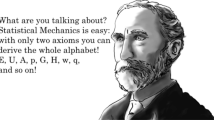Summary
It is shown by thermodynamical considerations, that in general regardless to the particular nature of a cell, there must be two kinds of forces between cells: a force of repulsion, due to metabolism, and a force of attraction, due to irritability.
It is shown, that the various geometrical forms, which cellular aggregates may assume under the influence of those forces, correspond in general features to various forms, found in nature.
In conclusion I wish to express my profound indebtedness to ProfessorDavenport Hooker, for frequent discussions of the subject and a great amount of valuable information.
Similar content being viewed by others
Literature
Gaskell, W. H., The Origin of Vertebrates.
Gerard, R. W., Nerve Conduction in Relation to Nerve Structure; Quart. Rev. Biol.6, 59, 1931.
Herrick, C. Judson, Brains of Rats and Men. Chicago University Press, 1926.
Kappers, Ariens, Further Contributions On Neurobiotaxis. IX. Journ. Comp. Neurol.,27, 261, 1917.
Lillif, R. S., Protoplasmic Action and Nervous Action. Chicago University Press. 1923.
Parker, G. H., Humoral Agents in nervous Activity. Cambridge University Press, 1932.
Ramon y Cajal, S., Hystologie du systeme nerveux. Vol. 2, p. 888, Paris, 1911.
Rashevsky, N., Physical Aspects of cellular Growth and Multiplication: Protoplasma,14, 99, 1931; b) Further Studies on the physical Aspects of cellular Growth and Multiplication. Protoplasma,15, 427, 1932; c) Some theoretical Aspects of the biological Applications of Physics of disperse Systems. Physics,1, 143, 1931; d) On the physical Nature of Cytotropism and allied Phenomena and their Bearing on the Physics of Organic Forms. Jl. Gen Physiol.15, 289, 1932; e) Contributions to the theoretical Physics of the Cell. Protoplasma,16, 387, 1932; f) Outline of a physico-mathematical Theorie of Excitation and Inhibition. Protoplasma; g) Zur theorie der bei Diffusion in kleinen Tropfen entstehenden Gleichgewichtsfiguren im Zusammenhang mit dem Formproblem in der Physik. Ztschr. f. Phys.56, 297, 1929.
Röhlich, Karl Gestaltungsbewegungen der praesumptiven Epidermis während der Neurulation und Kopfbildung. Arch. f. Entw.-Mech.124, 66, 1931.
Spemann, H. Vererbung und Entwickelungsmechanik. Naturwissenschaften.12, 65, 1924. Also a series of papersbySpemann and other in Arch. f. Entw.-Mech., beginning with 1918.
Vogt, W. Gestaltungsanalyse am Amphibienkeim mit örtlicher Vitalfärbung. I. Arch. f. Entw.-Mechan.106, 542, 1925. II Ibid. Arch. f. Entw.-Mechan.120, 384. 1929.
Author information
Authors and Affiliations
Additional information
With 1 Text-figure
Rights and permissions
About this article
Cite this article
Rashevsky, N. The theoretical physics of the cell as a basis for a general physico-chemical theory of organic form. Protoplasma 20, 180–188 (1933). https://doi.org/10.1007/BF02674824
Received:
Issue Date:
DOI: https://doi.org/10.1007/BF02674824



